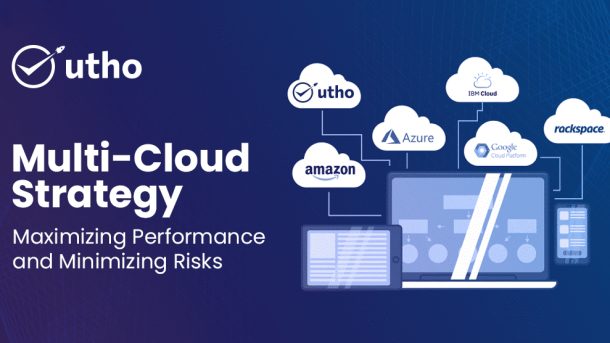How many cloud service providers does your company work with? If there is more than one, you are not alone. According to reliable sources, 89% of enterprises have adopted a multi-cloud strategy.
Choosing a multi-cloud approach offers significant benefits such as optimized performance, the ability to avoid vendor lock-in and access to best-in-class solutions.
However, moving beyond a single cloud provider also brings challenges and complexities, particularly in areas such as security, data protection and identity management.
In this blog, we explore what a multi-cloud strategy entails, how it works, and how effective identity management can help you overcome the challenges and maximize the benefits of a multi-cloud strategy.
Unlocking the Power of Multi-Cloud Strategies
Businesses can use different cloud services. Each has a role to play. They can make operations more efficient. The strategies include using many cloud computing and storage services. They are used in a single network. They offer many advantages. This is from combining public, private, and hybrid clouds.
Public Cloud Services
These companies provide the services. The services are scalable and cheap. They are for data storage and computing. Public clouds are good for businesses. They need flexibility and rapid growth. They do not want the burden of physical servers. With shared pricing, companies pay only for the services they use. This leads to big savings. It helps startups and small businesses with diverse needs.
Private Clouds
Private clouds are for a single organization. They offer better security and control over data and systems. Companies handle sensitive data or follow strict standards. They will find private clouds suitable. They offer strong security measures. They also offer options for customization. These allow businesses to tailor their infrastructure to their needs. However, they may require a higher upfront investment than public clouds.
Hybrid Clouds
Hybrid clouds blend the advantages of both public and private cloud environments. They offer businesses the best of both worlds. Enterprises can use public cloud services to run non-sensitive data and dynamic workloads. They can keep sensitive data in a secure private cloud. This hybrid cloud strategy enables businesses to move workloads between environments as needed. It enables them to do so cost-effectively. It also improves business continuity and disaster recovery. Data can be mirrored between the public and private parts of the hybrid cloud.
Creating a Multi-Cloud Strategy
Creating a multi-cloud strategy requires careful planning and consideration of various factors.
- Developing a multi-cloud strategy requires aligning business goals with technical capabilities. A good multi-cloud solution offers flexibility. It lets businesses switch between providers as their needs change. It also saves money. It lets companies use the low prices of different providers. They can pick the best one for each task.
- Using multiple clouds improves disaster recovery. It does this by sharing data and applications across different clouds. This approach increases flexibility. If one cloud provider has an outage or breach, operations can move to another cloud. This can happen without disruption. This minimizes risk.
- Automation and APIs are crucial in this context. Automation tools manage and move workloads to the cloud. They reduce manual work and the risk of error. APIs allow different cloud services to communicate seamlessly. They also help companies create and keep a unified multi-cloud environment.
- At Uthos, we follow the changes in the cloud world. The majority of cloud infrastructure costs come from cloud instances (Ec2/VM/VPS), managed databases (RDS) and Kubernetes (EKS/K8S). These services account for about 80% of the total bill. Our customers use Utho primarily to reduce the cost of these services in multi-cloud deployments.
Challenges and Overcoming Multi-Cloud Deployments
Overcoming barriers to multi-cloud adoption requires strategic problem-solving and innovative solutions.
Complexity and capability gaps
Managing multi-cloud systems can be complex. It often needs advanced expertise to create capabilities in an organization. Investing in training or hiring outside experts can help fill this gap. Picking the right partner for a multi-cloud deployment is critical. It's key to a successful implementation.
Cost Management
Multi-cloud strategies can save money. However, it's hard to manage costs across many providers. Without careful monitoring, costs can add up quickly. Using good cost management tools and strategies is essential. They keep costs under control in a multi-cloud environment.
Security and data compatibility issues
Sharing data across multiple clouds can boost security. But, it can also complicate compliance. This is due to different regulations in regions or industries. Coordinating security measures across various platforms is essential for effective management. Using the right tools and strategies can reduce these risks. They can also ensure compliance.
Data interoperability and integration
Integrating data between multiple clouds can be a hard task. This is due to the different formats and standards used by different services. To solve this problem, companies need the right tools. They also need the expertise for effective data connection and sharing.
By understanding these challenges and addressing them, companies can use multi-cloud deployments.
Factors to Consider When Implementing a Multi-Cloud Strategy
Ensuring a successful multi-cloud strategy requires careful consideration of various factors.
- Implementing a multi-cloud strategy is critical for businesses and involves several important steps. First, know your business needs and goals. These include the types of workloads, storage needs, and compliance.
- Next, compare cloud services. Create a matrix based on factors like reliability, security, and price. This will help you choose the best service providers for your needs. Then design a multi-cloud system. It will seamlessly mix different services. Consider the division of labor and system connections.
- Ensure strong data management and security. Do this by implementing policies on data storage and encryption. Use tools like CASB to increase security. Regular security audits help protect sensitive data and ensure compliance.
- Monitor and manage your multi-cloud environment to maintain visibility. Tools like Morpheus provide real-time performance. Management practices ensure compliance with requirements and efficient use of resources.
Continually optimize your multi-cloud setup. Do this by evaluating provider performance. Find ways to improve efficiency and cut costs.
What to look for in cloud service providers
When choosing a cloud service provider, companies should consider several key factors:
Strong security measures
Data security is a priority when choosing a cloud service provider. Look for providers that offer advanced features. These include encryption in transit and at rest. They also include two-factor authentication and regular security audits.
Scalability and flexibility
As businesses grow, their cloud needs change. A good cloud service provider should offer scalability. It should allow usage to grow or shrink as needed. Flexibility in the offered services and resources is crucial. They help to adapt to changing business needs.
Reliable customer support
Technical issues are inevitable, so reliable customer support is essential. Service providers have a dedicated support team. They can help resolve issues quickly. This minimizes downtime and failures.
Compliance and Credentials
Make sure the cloud provider follows the rules. These rules are for data storage. Service providers must be certified. They must also stay updated on the latest compliance requirements. This is needed to ensure legal and ethical data processing.
Cost considerations
Cloud services are an investment. It is important to consider the return. The right service provider balances cost and value. They provide quality services that support business growth without causing financial strain.
With these factors in mind. Companies can choose the best cloud provider for them. The provider must offer security, flexibility, and cost-effectiveness.
Unlocking the Future with Multicloud
Multicloud is a big change in cloud services. It alters how companies manage their IT. By leveraging multiple cloud platforms, businesses can maximize benefits and minimize dependencies.
Are you ready to step into the multi-cloud future? Request a demo and we'll explore your use cases together. We'll answer your pricing questions and find a plan that fits your business needs. Start your journey to unlock the future of cloud computing with Utho today.




